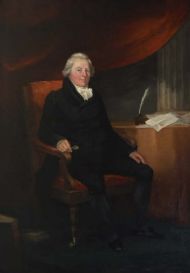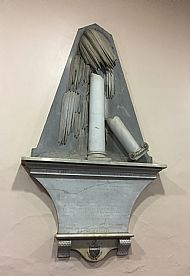Highland Scots - Inverness & area:
Inglis family
For family tree see Inglis on Ancestry (subscription required)
The Inglis family, originally from Nairn, had acquired the property of Kingsmills in Inverness by 1700. Alexander Inglis had two sons - Hugh (1711-82), who was an Inverness merchant and master of the ship Pledger, and George (1716-75), who emigrated to Charleston, Carolina.
The next generation of the family created an international network of family and business interests.
Hugh had five sons - both Alexander (1743-91, died after a duel) and John (d1781, murdered) emigrated to America; William (1747-1801, suicide) became a leading merchant and provost of Inverness; Hugh (d1796) was a shipmaster in the West India trade; and George (1764-1847) was a partner in a slave-trading business in St Vincent and then a planter in Demerara. Three of his four daughters married into local merchant families and the fourth, Helen, married Alexander Ross (d1805) of Gibralter.
In Carolina, George (1716-75) established himself as a leading merchant and one of his sons, Hugh Baillie Inglis (1770?-1830?), managed the ‘Inverness’ Inglis’ Demerara plantation, Bellefield, before moving to Berbice.
 William Inglis of Kingsmills (1747-1801), a merchant and banker in Inverness, was elected Baillie in 1791 and Provost in 1797, a post he held until 1800. He was responsible for raising funds to build a new jail, courthouse and steeple, and was also the driving force behind the establishment of Inverness Royal Academy and the Northern Infirmary, both of which received funds from planters in Guyana.
William Inglis of Kingsmills (1747-1801), a merchant and banker in Inverness, was elected Baillie in 1791 and Provost in 1797, a post he held until 1800. He was responsible for raising funds to build a new jail, courthouse and steeple, and was also the driving force behind the establishment of Inverness Royal Academy and the Northern Infirmary, both of which received funds from planters in Guyana.
William Inglis committed suicide during the night of 14th February 1801.
Provost Inglis, whom we all respected and esteemed, has destroyed himself; a sudden shock, occasioned by the elopement of his Banking clerk, who was also the active partner in the wine business , acting on a Plethoric [red faced, florid] Habit and a mind which felt severely any shock . . . He threw himself into the Ness from the middle arch [of the bridge] at half ebb in the morning of the 14th at ½ past 3 in the morning.
National Archives of Scotland, GD46/17/20, Letter to Lord Seaforth
 His brother George then took on the management of the family business and affairs. He wrote: ‘My mind, it is rendered miserable beyond the power of utterance’ and within a year he had left the town for Bristol ‘rather than give to some Envious narrow minded wretches in this little community the malignant satisfaction of triumphing in the adversity of our family.’
His brother George then took on the management of the family business and affairs. He wrote: ‘My mind, it is rendered miserable beyond the power of utterance’ and within a year he had left the town for Bristol ‘rather than give to some Envious narrow minded wretches in this little community the malignant satisfaction of triumphing in the adversity of our family.’
Left: memorial erected by George Inglis to his brother William (Old High Church, Inverness)
The Inglis family and Demerara
Hugh Inglis (d1796)
William's brother, Hugh Inglis, was a shipmaster in the West India trade.
George Inglis (1764-1847)
The youngest brother, George Inglis, was by 1790 in a highly profitable partnership in St Vincent with George Baillie and the Alves brothers, Archibald and William. George Inglis had earlier been Baillie's clerk and he was also in partnership, at one point, with George Baillie's cousin, Evan, an Inverness-born slave trader based in Bristol.
George subsequently acquired property in Demerara and in 1792 returned to St Vincent to dissolve the partnership. His brother Hugh (shipmaster) wrote to William, in Inverness:
George . . . reckons himself worth £6000. This is a handsome sum for a young man and acquired very speedily for George had not much to reckon on when he took it into his head to become a Demerary planter. [Inglis papers, Inverness Museum]
In late 1793 the partnership of Fraser, Inglis & Co in Demerara was dissolved [Essequebo en Demerarische Courant]. By 1798 the family owned two adjoining plantations on the coast, Bellefield and Phoenix Park, each of 250 acres and growing cotton.
George had returned to Inverness by this time, where he married Helen Alves, the sister of his former partners in St Vincent. He had already had a relationship with a 'free mulatto woman', Susanne Kerr, who lived with him in both St Vincent and Demerara, and by whom he had at least four children, Helen, William, Hugh and George, all of whom were brought to Inverness to be educated. [Transcription of Susanne Kerr's will]
Bellefield was mortgaged to John Gladstone in 1810 and financial difficulties forced George to return to Demerara in 1813 to manage his affairs there. His notebook shows him to have been suspicious of Gladstone, deeply concerned about his wife and children in England and also determined to improve the condition fo the slaves on his plantation. He was also, by this date, deeply religious in his outlook. He returned to Britain in 1814. [Transcription of George Inglis' Demerara notebook]
Hugh B Inglis (1770?-1830?)
By 1801 the Demerara plantations were managed by a cousin, Hugh B Inglis (a son of George Inglis of Charleston, Carolina). In letters from Inverness, George repleatedly complained of lack of information from Hugh on the state of the plantation, the income from which was vital to the management of the 'Inverness' Inglis' finances.
Hugh B Inglis intended to leave Demerara in 1804 [E&DG 31 Mar 1804] and may have done so but was again in the colony in 1806, when he made a trip up the Correntyne described by Thomas Staunton St Clair in A Residence in the West Indies [1834]. His plantation on the Corentyne coast, Clifton, was threatened with judicial sale at the instance of his creditors in 1811 [London Gazette] but he was still in possession in 1817, when his attorney made a return for 55 slaves. By 1822 ownership had passed to John Bethune.
1822 Hugh B Inglis made a return for two slaves of his own and on behalf of the minors Eliza, Harriet, William and Hugh Inglis. (In 1819 11 slaves had been returned by Mary Inglis on behalf of her brothers and sisters Catherine, Eliza, Harriet, William, Hugh and Henry. Catherine made her own return in 1822). It is probable that these seven were the children of Hugh B Inglis.
In 1825 he advertised his intention to leave the colony with Harriet Inglis and a servant named Mary Rose (Berbice Gazette, 1 June 1825)
Local patronage
'In Demerara, where there was a strong Scottish presence, the operation of patronage within well-defined local and kinship groups was well established and articulated through correspondence. George Inglis of Inverness owned Bellefield plantation in Demerara, which was managed by his cousin Hugh Inglis. Additionally, George was active in recruiting in the Inverness area, and was particularly keen when he happened upon a candidate he felt had potential.'
A Global Clan: Scottish Migrant Networks and Identities since the Eighteenth Century
Angela McCarthy (ed.) London, 2006, p248
There is a Gentleman who is from this place, and was in the habit of corresponding with my lamented Brother, who I find by a letter just received from him has lately been appointed Commissary of Stores at Demry. – He is Mr Robert Patterson . . . I have not a doubt that you may be usefully beneficial to each other. I have written to this Gentleman to see if he would provide a Birth in his Department for a fine lad a brother of Phineas McIntosh but I think greatly more promising . . . If I can do anything for him with Mr Patterson it will make me happy, if not, he must go out as an Overseer, in which case I must get you and Dr Chisholm to procure a proper Birth for him.
Inverness Museum, Letter book of George Inglis, 22 May 1801
The letter book shows George seeking positions for a number of 'young lads' including William Mackintosh of Ballifeary.
For more detail of the Inverness 'network' in the Caribbean see Douglas Hamilton, Scotland, the Caribbean and the Atlantic world, 1750-1820 [Manchester, 2005].
Information on the Inglis family on this page has been updated and corrected thanks to Jim Brennan, Inverness.
The Inglis legacy in Inverness
Although he died two years before the opening of the Northern Infirmary, Willliam Inglis' name appeared prominently on the facade of the building. In 2009 a plaque was placed on the building acknowledging for the first time the source of much of the funds.



